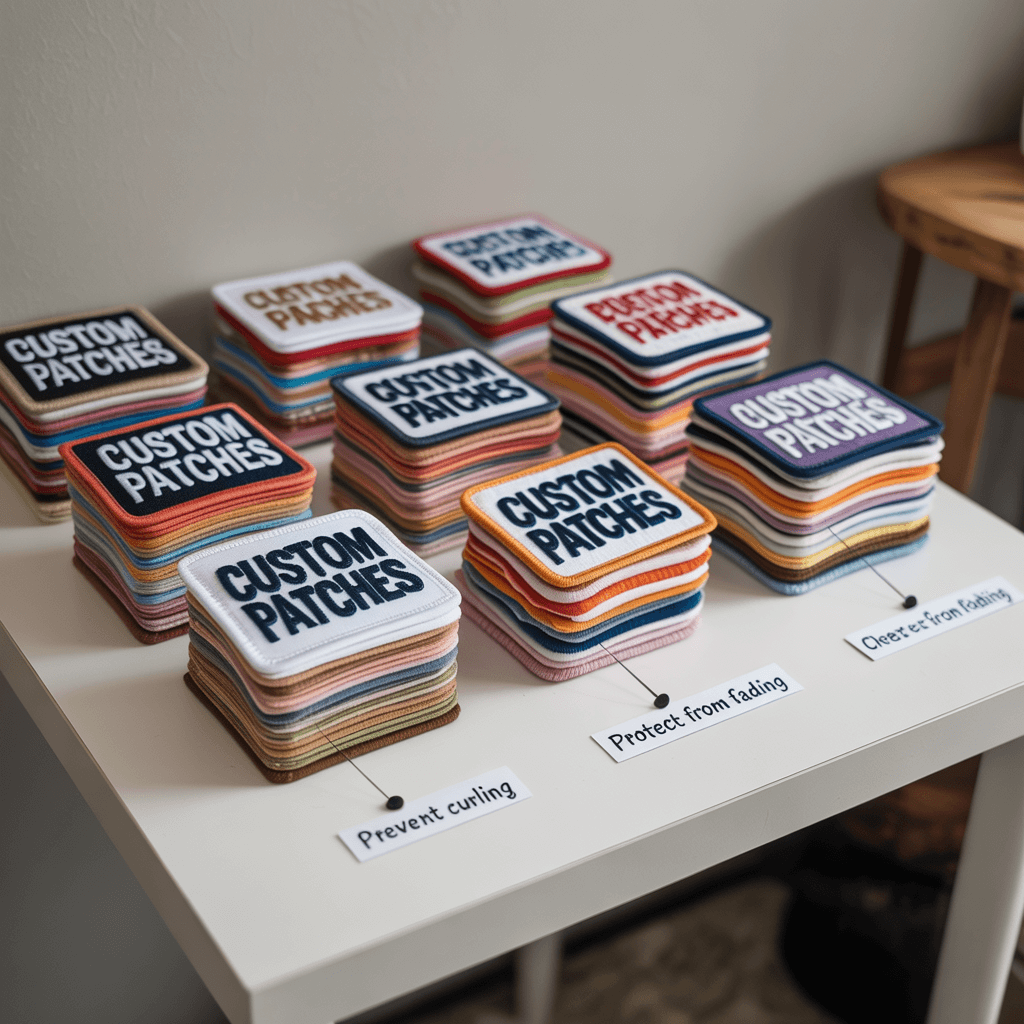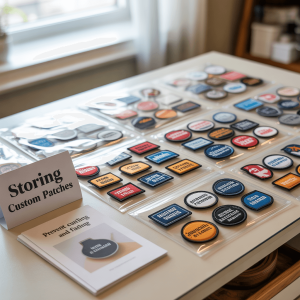You’ve got your shiny new batch of custom patches, stitched to perfection, colours popping, your logo crisp enough to make a printer jealous. They’re ready for uniforms, merch drops, or the next big event. Then a few weeks later… disaster. The corners start curling, threads lose their shape, and suddenly your once-slick patches look like they’ve survived a heatwave in a greenhouse.
Relax, it’s not your supplier’s fault. It’s storage sabotage.
The truth? Patches are a lot like plants (but far less demanding). Treat them right, and they’ll stay flat, bright, and flawless for years. Treat them wrong, humidity, light, and pressure will warp them faster than you can say “where did I store that box?”
Today, we’re diving into inventory care for patches, whether you’re running a small brand, a local club, or a full-blown merch warehouse. Because patch quality doesn’t end at production, it thrives in proper storage.
Why Patch Storage Matters More Than You Think
A patch is an investment. For clubs, brands, and businesses, it’s identity, marketing, and reputation sewn into one. But once your custom embroidered patches arrive, they’re still vulnerable to environmental damage before ever reaching a jacket or cap.
Here’s the problem:
- Humidity makes patches curl and warp.
- Excessive light fades colours.
- Stacking without protection ruins shape and stitchwork.
- Improper ventilation invites mildew or adhesive breakdown.
The fix? Not rocket science, just smart storage tactics used by pros who deal in high-volume, high-quality patch inventory daily.
Before we get into the how-to, let’s clear one thing up, you can buy from the best patch maker in the UK, but even the highest quality patches will misbehave if stored like afterthoughts in a dusty storeroom.
So let’s fix that.
Step 1: Flat, Firm, and Fabulous (The Storage Foundation)
First things first, keep patches flat. That’s non-negotiable. Curled patches are not just ugly; they’re nearly impossible to apply evenly, especially for iron-on or PVC patches.
Use Backing Cards or Sheets
Lay each patch (or sets of patches) on acid-free cardstock or polypropylene sheets. This prevents bending and keeps them firm. Avoid random cardboard boxes, they can absorb moisture and warp fabric over time.
Use Plastic Sleeves
Clear sleeves (like trading card sleeves or document protectors) are brilliant for smaller quantities. They protect from dust, humidity, and direct contact with other materials. Bonus: they make cataloguing easier when dealing with bulk custom patches for uniforms or events.
Avoid Overstacking
Yes, we know, storage space isn’t infinite. But squishing your patches under weight is asking for wrinkling and bending. Keep stacks under 1.5 inches high, and separate layers with silica paper or non-stick sheets.
Step 2: Humidity (The Silent Patch Killer)
Humidity is patch kryptonite. Whether you’re storing custom iron on patches or embroidered ones, moisture makes adhesive backings weak and causes threads to loosen.
Ideal Humidity: 40–50%
That’s your magic number. Use a small hygrometer in your storage area to keep tabs.
Silica Gel Packs Are Your Best Mates
Toss a few into storage bins or drawers. They’ll absorb excess moisture and stop curling before it starts.
Avoid Basements and Attics
Unless you want patches that smell like old paperbacks and mildew. Choose dry, temperature-stable rooms, ideally between 18°C and 22°C.
Pro tip: If you’re keeping inventory long-term, use airtight bins with moisture absorbers. A small investment, but a massive win for patch lifespan.
Step 3: Light Exposure (Keep It Dim, Keep It Fresh)
Sunlight fades thread and backing colours. Even LED light, over time, can dull embroidery sheen. So unless your storage room doubles as an art exhibit, avoid direct light exposure.
Use Opaque Bins or Drawers
Store your patches in dark, enclosed spaces, cupboards, drawers, or opaque plastic containers.
Rotate Display Stock
If you display patches in your store or on event stands, rotate them regularly to avoid sun bleaching on one side.
If you’re selling online and taking product photos, keep lighting sessions short and avoid heat lamps that might affect the adhesive layers.
Step 4: Storage Temperature (Keep It Cool)
Extreme temperature shifts cause backing adhesives to break down or become sticky. That’s bad news if you’re dealing with custom logo patches for jackets or bags, which often use heat-seal backings.
Stick to this golden rule:
“If you wouldn’t store wine or chocolate there, don’t store your patches there either.”
Ideal Range: 18°C – 22°C
Consistent and cool. Avoid leaving them in vehicles, garages, or near radiators.
Avoid Plastic Bags for Long-Term Storage
They can trap heat and moisture. Instead, go for breathable containers with silica packets.
Step 5: Proper Packaging for Business Inventory
If you’re a custom patch maker or a brand keeping bulk stock, say, for custom team patches for sports uniforms or corporate logo patches UK made, you need professional-level organisation.
Use Labelled Dividers
Separate patches by design, size, or client using dividers or cards. Nothing’s worse than mixing up a client’s “Summer Festival” patch order with your “Christmas promo” stock.
Keep Inventory Logs
Track quantity, date received, and batch details. For large orders, note adhesive type, e.g., iron-on, Velcro, or sew-on patches for clothes.
Short-Term vs Long-Term Stock
Stock you plan to dispatch within weeks can stay in shallow trays or shelves. Long-term stock? Airtight bins with humidity control are a must.
For detailed patch care, check out our post: How to Care for and Maintain Your Embroidered Patches?, it’s the ultimate handbook for keeping your designs as sharp as day one.
Step 6: Handle With Care (Because Fingerprints Aren’t a Texture)
Even when stored perfectly, the way you handle your custom patches can make or break their lifespan. Oils, dirt, and even lotions from your hands can dull the threads or weaken adhesive layers over time. Sounds dramatic? Not really, especially for custom logo patches for hats or jackets, where a single greasy smudge can ruin the finish.
Always Handle with Clean, Dry Hands
Before touching or sorting, give your hands a quick wash and dry. Better yet, use light cotton gloves when dealing with embroidered, chenille, or PVC patches. You’ll avoid fingerprints, lint, or unexpected thread pulls.
No Folding, Ever
If you’ve got custom embroidered patches for hoodies or biker patches for jackets, don’t fold them to fit into small drawers or boxes. Fold lines are permanent scars on fabric-based patches. Always keep them flat, if you’re short on space, store them vertically like vinyl records instead.
Mind the Adhesive
Avoid touching the back side of iron-on patches or heat seal patches. Oils can reduce adhesion power, and when it’s time to apply them, they might not stick as strongly as they should.
Step 7: Don’t Let the Curl Win (The Fix If It Happens)
So, despite your best efforts, a few patches decided to do the wave? Don’t panic. Curling doesn’t always mean ruin, especially if caught early.
Here’s how to flatten curled patches safely:
- Use a Clean Iron:
Set your iron to a low heat (no steam). Place a clean cotton cloth over the patch and press gently for a few seconds. Never iron directly on the embroidery or adhesive backing. - Try a Heavy Book Trick:
Place curled patches between parchment sheets and leave them under a heavy book overnight. Slow, even pressure works wonders. - Skip the Hair Straightener Hack:
Yes, the internet says it works. No, you shouldn’t do it. Uneven heat can damage the backing or melt PVC patches completely.
For washing and reusing patches without damage, see our expert guide: How to Wash Custom Patches Without Damage | Expert Guide UK
Because even after they’ve survived humidity and light, one wrong wash can still send them to patch heaven.
Step 8: Patch-Specific Storage (Because One Size Doesn’t Fit All)
Different patch types react differently to environmental factors. Knowing your patch personality helps you store them like a pro.
Custom Embroidered Patches
They’re durable, but threads can fray with friction. Store them with fabric side up, layered with soft tissue or felt in between. Avoid rubber bands or clips that snag threads.
Custom Woven & Printed Patches
These are thinner and more flexible, which means they curl faster. Keep them sandwiched between cardstock or stored in sleeves to maintain structure.
Custom PVC & Rubber Patches
PVC patches are tough, but adhesives can be temperature-sensitive. Store them flat, away from sunlight and heat sources. Avoid airtight plastic bags unless you’ve included desiccants.
Custom Chenille & Bullion Patches
These luxury textures need airflow. Use breathable boxes or mesh fabric pouches. Never seal them in vacuum bags, trapped moisture is their worst enemy.
Iron-On & Heat-Seal Patches
Temperature stability is key. Avoid stacking them in hot environments, and keep backing papers attached until they’re ready for use.
Velcro & Sew-On Patches
These are sturdy but attract lint like magnets. Store them in resealable pouches or small compartments to avoid cross-texture transfer.
Step 9: Business-Level Patch Storage (For Brands & Distributors)
If you’re running a brand, team supply, or uniform business, patch inventory is more than just “merch”, it’s capital. Poor storage equals financial loss.
Here’s how smart brands do it:
Batch Tagging System
Assign each design batch a unique code. Helps track older stock before new batches roll in (first in, first out). Especially handy if you order bulk custom patches for jackets or corporate logo patches UK made.
Climate-Controlled Storage
If your inventory size justifies it, small dehumidifiers are game-changers. A consistent climate means consistent quality, crucial for fast turnaround custom patches UK services.
Visual Inventory System
Take high-quality digital photos of each patch type and link them to your digital catalog or POS. This reduces physical handling, keeps stock pristine, and speeds up your reorder cycle.
Seasonal Patch Management
Got custom patches for Christmas, Easter, or festivals? Store them in seasonal bins labeled by event. Avoid keeping unused stock out year-round, rotate them out after the season ends.
Step 10: Shipping and Travel (Keeping Them Flat on the Go)
Whether you’re sending patches to clients, trade shows, or your own fulfillment centers, bad packaging during shipping can undo all your careful storage.
Use Rigid Mailers or Flat Boxes
Never use flimsy envelopes. For smaller quantities, rigid mailers prevent bends. For larger orders, flat cardboard boxes with interleaving sheets work best.
Temperature-Proof Transport
If you’re using adhesive-backed patches, avoid leaving parcels in vehicles or hot warehouses. Extreme heat can soften adhesive and cause sticking.
Separate Patch Types
PVC patches should never travel in the same tight space as embroidered or chenille ones, friction and pressure can deform the softer textures.
If you’re offering rush order custom patches UK, invest in moisture-resistant courier packaging. It’s about making sure your product arrives in display-ready condition.
FAQs
1. Why do my custom patches curl or warp over time?
Patches often curl due to exposure to humidity, heat, or uneven surfaces during storage. Keeping them flat in acid-free containers and away from moisture prevents warping.
2. What’s the best way to store custom embroidered patches?
Use flat storage boxes with interleaving tissue or cards. Keep them in a cool, dry place with low humidity. Avoid stacking heavy items on top to prevent creasing.
3. Can PVC or rubber patches get damaged in heat?
Yes, extreme heat can soften adhesives or warp PVC materials. Always store PVC patches in a temperature-controlled space, away from direct sunlight or radiators.
4. How do I flatten curled patches safely?
Place a clean cloth over the patch and lightly press it with a warm (not hot) iron for a few seconds. Never iron directly on embroidery or adhesive backing.
5. Should I store patches in plastic bags or containers?
Use breathable containers or boxes with desiccants. Avoid sealed plastic bags without airflow, trapped moisture can lead to mildew or adhesive breakdown.
6. What’s the ideal humidity level for patch storage?
Keep humidity between 40–50%. Too much moisture can cause adhesive or backing to soften; too little can make custom patches brittle.
7. How can brands store large quantities of patches safely?
For bulk patch storage, use labeled bins with anti-moisture packs, maintain consistent temperature, and rotate inventory regularly. Avoid overstacking to preserve quality.
8. Can I hang patches on boards for display without damaging them?
Yes, but use acid-free backing boards and avoid areas with direct light or heat. If displayed for long periods, rotate them occasionally to prevent fading.
Store Smart, Sell Proud
Your custom patches represent your brand’s precision, pride, and identity. You put thought into design, invested in the best patch makers in the UK, and trusted a custom patch maker near you for quality, so don’t let poor storage undo that craftsmanship.
With the right environment, care, and handling, patches can last for years, ready to stick, sew, or shine at a moment’s notice. Whether you’re storing custom patches for small businesses, team uniforms, or corporate giveaways, your inventory deserves the same respect as your brand logo.
Want help designing, manufacturing, or restocking your next batch? Contact us today to design your own patch and order from the UK’s #1 Custom Patch Manufacturer. Your patches deserve better than curling corners. Let’s keep them perfect from design to delivery.







